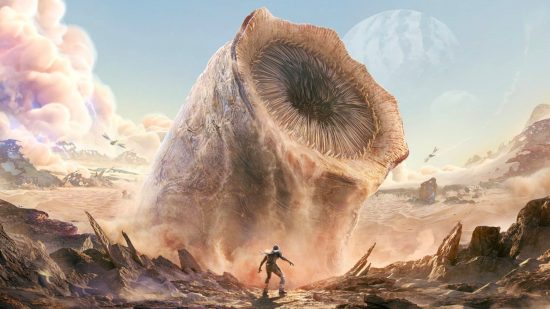The Dune Awakening trailer just dropped, revealing what looks to be a tantalizing take on how to build a non-linear game from a book and film so steeped in a grand, epic tale centered on a single character. However, while I’m excited by the innovative survival mechanics of the game, and the intricate way in which the developers have recreated the look and feel of the Denis Villeneuve movies, there’s one aspect that just doesn’t deliver. Where’s all the sand!?
I don’t mean all the rolling distant sand dunes or static drifts of the stuff littered about the corridors depicted in Dune Awakening‘s buildings. I mean the sort of qualities of sand that poor old Anakin so lamented all those years ago. The sand that’s coarse, irritating, and gets everywhere.

One of the most wonderful aspects of the Denis Villeneuve movies is that every moment on Arrakis evokes the scorching, shimmering, all-encompassing, ever-floating presence of particles in the air and the constantly moving flow of the dunes. So much of the grandeur and presence of the place comes from the constant requirement to squint and ponder. Is that a giant worm, a spice harvester, or just a rock?
When we see shots of giant sand worms cresting the horizon or ornithopters rising from Arrakis in this trailer, however, while the developers have managed to add a few mild puffs of sandy cloud, by and large, there’s nothing like the great plumes of dust, sand, and spice you’d expect in such circumstances.
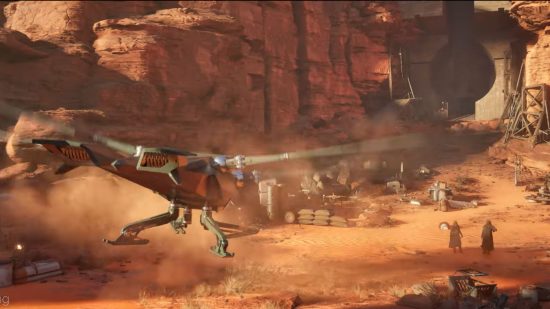
Moreover, there’s no movement of the sand. The worms don’t burst forth from it in a convincing, flowing way, nor is it kicked and swirled around as characters interact with it. For a world that is so defined by this singular dusty, spicy, sandy environment, it doesn’t quite convince.
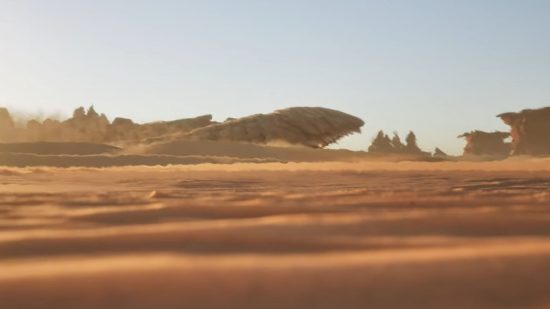
While some of this lack of spicy visuals could be down to the game still being in the early stages of development, I have my doubts that it will suddenly take on the look that I want. After all, it’s being built on Unreal Engine 5, which is well known for being incredibly capable when it comes to delivering a very finished-looking product right from the off.
Instead, I suspect the sorts of sand plumes, ever-present dusty-aired quality, and flowing terrain that I envisage are going to crash head-on into the limit of current graphics hardware.
You see, while modern games can look amazing, thanks to technologies such as ray tracing, mesh shaders, and much more, at their heart they’re still based on the fundamental principle of simplifying a scene as much as possible. Whenever there’s a chance, the surfaces that define the models in a 3D game are flattened down to have as few details as possible while still looking good. Most of the detail we actually see is made by painting 2D images (textures) onto those models or applying other effects trickery.
It’s a fact that’s discussed in the trailer by the game’s creative director, Joel Bylos. He talks about the Nanite feature of UE5 that allows for the game to dynamically change the level of detail (the LOD that he refers to in the video) of a model depending on how close or far away it is from the player’s view. If it’s far off, you can get away with using a low-detail model to describe that object.
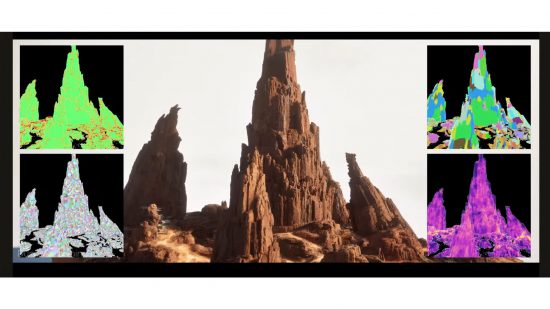
That’s all well and good for larger models onto which the game can paste a 2D texture, but when it comes to effects like flowing sand dunes, dust clouds, or smoke, the situation gets a lot trickier.
To produce realistic-looking dust plumes or flowing dunes, the game needs to simulate the nearly countless number of particles that make up the cloud/dune, defining how each one interacts with the other objects in the scene. Modern computer games can have millions of triangles that define the 3D models of the game onscreen at any one time, but add in the sort of particle effects that make for convincing dust plumes or flowing sand disappearing off into the distance and you could be adding billions more particles.
On top of there simply being too many particles, such effects also require more complex physics calculations than are typically required for rendering normal game scenes. You need to start firing up fluid dynamics equations to work out just how sand, dust, and spice might move and flow around the fluttering wings of an ornithopter.

Many advancements have been made in optimizing the generation of particle effects, with tools such as Nvidia Flameworks providing a relatively efficient means to generate fire, smoke, and explosion effects – and that came out ten years ago. Indeed, we’ve seen in games like Forza Horizon 5 that particle effects have come a long way and can be integrated quite neatly into certain game scenarios. And, in fact, some scenes from the Dune Awakening trailer do show quite realistic, small-scale particle effects, such as the dusty winds surrounding our player character in the image below.
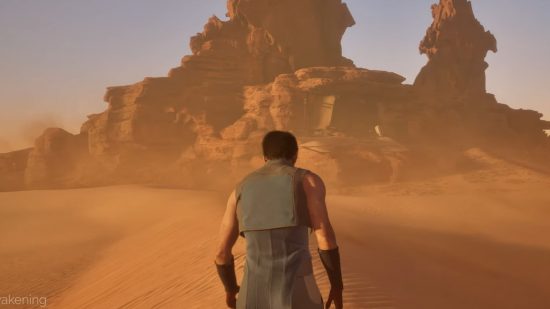
However, few games have ever had to deal with the sheer scale of particles needed to describe an entire desert planet. Ideally, there would be an almost constant haziness to the environment, an ever-present shifting quality to the sand dunes, with the wind affecting their shape, and footsteps would not just leave a mark but deform the surface of the sand. Then there’s also the complexity of modeling how a worm might burst forth through the trillions of grains of sand that it would displace.
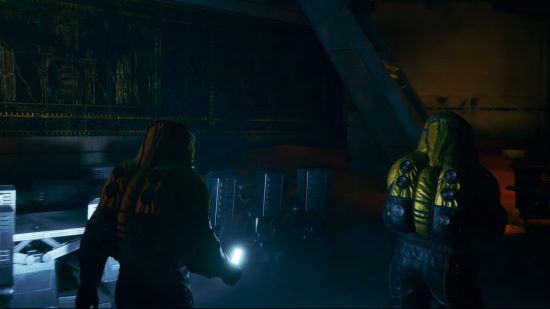
It also doesn’t help that there are moments in the trailer where that telltale UE5 slightly shiny look appears on, most noticeably, the character models. Yes, their suits are probably made of various potentially shiny materials, but in an environment such as this one, they would constantly be dulled by the dust.
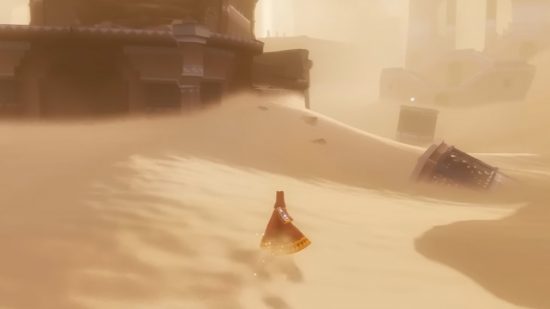
While these problems are likely to be tricky to solve, there is some hope. Games such as Journey (above) manage to evoke much more of the feeling of a constantly hazy, dusty environment by using clever art design and some well-executed gusts of dusty wind, as well as deforming terrain effects (note the divots in the sand where the character has walked).
It’s a much less ‘realistic’ looking game than Dune Awakening, so it’s easier to get away with only evoking the impression of sandiness rather than trying to produce a wholly lifelike reproduction, but some of the same subtleties could surely be integrated.
As such, I live in hope that the final version of Dune Awakening can implement a few more of these subtle effects to deepen the sense of place and truly do justice to the magnificence that is Frank Herbert’s original book and Denis Villeneuve’s awe-inspiring movie adaptation. In the meantime, you can read our wider initial impressions of the game in our Dune Awakening preview, where Paul looks at the gameplay and story ideas behind the game.
